Using Machine Learning and Analytical Modeling to Predict Poly-Crystalline PV Performance in Jordan
Abstract
1. Introduction
2. Methods
2.1. The Analytical Model of Energy Collection on Poly-Crystalline PV Systems
- (1)
- In the case of the poly-crystalline EW-directed PV system, the yearly analytical and experimental electrical power generation is 1433.9 and 1478.7 kWh/kWp, respectively, which are in close agreement (the error value equals 3.12%).
- (2)
- In the case of the poly-crystalline south-directed PV system, the yearly analytical and experimental electrical power generation is 1772.9 and 1633 kWh/kWp, respectively, which are also in close agreement (the error value equals 7.89%).
- (3)
- The results show that the productivity of the poly-crystalline south-directed PV system is better than that of the EW-directed PV system, with power gains of 23.64 and 10.43% using the analytical and experimental methods, respectively.
2.2. Machine Learning Modeling
2.2.1. Choice of Learning Algorithms
2.2.2. Performance Measures
2.2.3. Model Training and Validation
3. Results
3.1. Machine Learning Predictions of PV Systems
3.1.1. Poly South Predictions
3.1.2. Poly EW Predictions
4. Discussion
5. Conclusions and Future Work
- In the case of the poly-crystalline EW-directed PV system, the yearly analytical electrical power generation is 1433.9 kWh/kWp, where the error value is 3.12% as compared with the experimental value. The yearly electrical power generation predicted by linear regression is 1510.45 kWh/kWp, where the error value is 2.1% as compared with the experimental value. It is seen that the prediction of experimental data by linear regression is very accurate, with an accuracy better than that of the analytical method.
- In the case of the poly-crystalline south-directed PV system, the yearly analytical electrical power generation is 1772.9 kWh/kWp, where the error value is 7.89% as compared with the experimental value. For prediction by linear regression, the yearly electrical power generation is 1658.15 kWh/kWp, where the error value is 1.5% as compared with the experimental value. It can also be noted here that the prediction of experimental data by linear regression is very accurate, with an accuracy better than that of the analytical method.
- The results show that the productivity of the poly-crystalline south-directed PV system is better than that of the poly-crystalline EW-directed PV system, with power gains of 23.64% using the analytical method, 10.43% using the experimental method, and 9.77% using prediction by linear regression.
- The superior performance of the linear regression model across all evaluation metrics (the MSE, RMSE, MAE, and R2) in both the poly south and poly EW PV systems can be attributed to several factors. First, the dataset revealed a dominant linear relationship between solar radiation and power yield, as shown in the correlation matrices (Figure 1 and Figure 6), where radiation exhibited the highest positive correlation with output energy. Given that linear regression thrives in contexts where the dependent variable has a strong, linear association with one or more independent variables, this direct relationship likely enabled the model to achieve high predictive accuracy with minimal complexity. By contrast, more complex models such as LASSO, ElasticNet, and ANNs incorporate regularization or nonlinearity, which, while powerful in high-dimensional or noisy environments, can lead to overfitting or underfitting when the underlying patterns are inherently simple. Moreover, the relative sparsity of the features’ interdependence and the limited presence of strong nonlinear interactions further reduced the advantage of using advanced models. Linear regression, with advantages of simplicity and interpretability, was able to generalize well to the test data, yielding error rates even lower than the analytical model and closely matching experimental values, with yearly prediction errors as low as 1.5 and 2.1% for the south and EW systems, respectively. These findings emphasize that in certain practical scenarios with clean, well-structured datasets and dominant linear features, classical statistical methods can outperform more sophisticated machine learning models.
Author Contributions
Funding
Data Availability Statement
Acknowledgments
Conflicts of Interest
Abbreviations
| PV | Photovoltaic |
| AI | Artificial Intelligence |
| ML | Machine learning |
| MSE | Mean Square Error |
| RMSE | Root Mean Square Error |
| MAE | Mean Absolute Error |
References
- International Energy Agency. World Energy Outlook 2022; IEA: Paris, France, 2022; Available online: https://www.iea.org/reports/world-energy-outlook-2024/executive-summary (accessed on 22 May 2025).
- Solar Power Europe. Global Market Outlook for Photovoltaics 2022–2026; SolarPower Europe: Brussels, Belgium, 2022. Available online: https://www.memr.gov.jo/EBV4.0/Root_Storage/EN/EB_Info_Page/Summery_of_the_Comprehensive_Strategy_of_the_Energy_Sector_2020_2030.pdf (accessed on 22 May 2025).
- SolarQuarter. The Future Looks Bright for Solar Energy in Jordan: A 2023 Outlook. Available online: https://solarquarter.com/2023/02/25/the-future-looks-bright-for-solar-energy-in-jordan-a-2023-outlook/ (accessed on 22 May 2025).
- Ministry of Energy and Mineral Resources. Summary of Jordan Energy Strategy 2020–2030; MEMR: Amman, Jordan, 2022. Available online: https://www.memr.gov.jo/EN/Pages/_Strategic_Plan_ (accessed on 10 April 2025).
- Tina, G.M.; Ventura, C.; Ferlito, S.; De Vito, S. A State-of-Art Review on Machine-Learning-Based Methods for PV. Appl. Sci. 2021, 11, 7550. [Google Scholar] [CrossRef]
- Akhter, M.N.; Mekhilef, S.; Mokhlis, H.; Shah, N.M. Review on Forecasting of Photovoltaic Power Generation Based on Machine Learning and Metaheuristic Techniques. IET Renew. Power Gener. 2019, 13, 1009–1023. [Google Scholar] [CrossRef]
- Zhaoxuan, S.M.; Rahman, M.; Vega, R.; Dong, B. A Hierarchical Approach Using Machine Learning Methods in Solar Photovoltaic Energy Production Forecasting. Energies 2016, 9, 55. [Google Scholar] [CrossRef]
- Van Tai, D. Solar Photovoltaic Power Output Forecasting Using Machine Learning Technique. J. Phys. Conf. Ser. 2019, 1327, 012051. [Google Scholar] [CrossRef]
- Nageem, R.; Jayabarathi, R. Predicting the Power Output of a Grid-Connected Solar Panel Using Multi-Input Support Vector Regression. Procedia Comput. Sci. 2017, 115, 723–730. [Google Scholar] [CrossRef]
- AlKandari, M.; Ahmad, I. Solar Power Generation Forecasting Using Ensemble Approach Based on Deep Learning and Statistical Methods. Appl. Comput. Inform. 2019, 20, 231–250. [Google Scholar] [CrossRef]
- Anuradha, K.; Erlapally, D.; Karuna, G.; Srilakshmi, V.; Adilakshmi, K. Analysis of Solar Power Generation Forecasting Using Machine Learning Techniques. E3S Web Conf. 2021, 309, 01163. [Google Scholar] [CrossRef]
- Louzazni, M.; Mosalam, H.; Khouya, A.; Amechnoue, K. A Non-Linear Auto-Regressive Exogenous Method to Forecast the Photovoltaic Power Output. Sustain. Energy Technol. Assess. 2020, 38, 100670. [Google Scholar] [CrossRef]
- Louzazni, M.; Mosalam, H.; Cotfas, D.T. Forecasting of Photovoltaic Power by Means of Non-Linear Auto-Regressive Exogenous Artificial Neural Network and Time Series Analysis. Electronics 2021, 10, 1953. [Google Scholar] [CrossRef]
- Patel, A.; Swathika, O.V.G.; Subramaniam, U.; Babu, T.S.; Tripathi, A.; Nag, S.; Karthick, A.; Muhibbullah, M. Practical Approach for Predicting Power in a Small-Scale Off-Grid Photovoltaic System Using Machine Learning Algorithms. Int. J. Photoenergy 2022, 2022, 9194537. [Google Scholar] [CrossRef]
- Yadav, O.; Kannan, R.; Meraj, S.T.; Masaoud, A. Machine Learning Based Prediction of Output PV Power in India and Malaysia with the Use of Statistical Regression. Math. Probl. Eng. 2022, 2022, 5680635. [Google Scholar] [CrossRef]
- Khandakar, A.; Chowdhury, M.E.H.; Kazi, M.K.; Benhmed, K.; Touati, F.; Al-Hitmi, M.; Gonzales, A.J.S.P. Machine Learning Based Photovoltaics (PV) Power Prediction Using Different Environmental Parameters of Qatar. Energies 2019, 12, 2782. [Google Scholar] [CrossRef]
- Kumar, B.S.; Mahilraj, J.; Chaurasia, R.K.; Dalai, C.; Seikh, A.H.; Mohammed, S.M.A.K.; Subbiah, R.; Diriba, A. Prediction of Photovoltaic Power by ANN Based on Various Environmental Factors in India. Int. J. Photoenergy 2022, 2022, 4905980. [Google Scholar]
- Berghout, T.; Benbouzid, M.; Bentrcia, T.; Ma, X.; Djurovic, S.; Mouss, L.H. Machine Learning-Based Condition Monitoring for PV Systems: State of the Art and Future Prospects. Energies 2021, 14, 6316. [Google Scholar] [CrossRef]
- Garoudja, E.; Chouder, A.; Kara, K.; Silvestre, S. An Enhanced Machine Learning Based Approach for Failures Detection and Diagnosis of PV Systems. Energy Convers. Manag. 2017, 151, 496–513. [Google Scholar] [CrossRef]
- Takruri, M.; Farhat, M.; Barambones, O.; Ramos-Hernanz, J.A.; Turkieh, M.J.; Badawi, M.; AlZoubi, H.; Sakur, M.A. Maximum Power Point Tracking of PV System Based on Machine Learning. Energies 2020, 13, 692. [Google Scholar] [CrossRef]
- Nkambule, M.S.; Hasan, A.N.; Ali, A.; Hong, J.; Geem, Z.W. Comprehensive Evaluation of Machine Learning MPPT Algorithms for a PV System Under Different Weather Conditions. J. Electr. Eng. Technol. 2020, 16, 411–427. [Google Scholar] [CrossRef]
- Edalati, S.; Ameri, M.; Iranmanesh, M. Comparative Performance Investigation of Mono- and Poly-Crystalline Silicon Photovoltaic Modules for Use in Grid-Connected Photovoltaic Systems in Dry Climates. Appl. Energy 2015, 160, 255–265. [Google Scholar] [CrossRef]
- Abdallah, S.; Salameh, D. Technical and Economic Viability Assessment of Different Photovoltaic Grid-Connected Systems in Jordan. In Lecture Notes in Mechanical Engineering; Springer: Cham, Switzerland, 2020; pp. 291–303. [Google Scholar]
- Duffie, J.A.; Beckman, W.A.; Blair, N. Solar Engineering of Thermal Processes, Photovoltaics and Wind, 5th ed.; John Wiley & Sons: Hoboken, NJ, USA, 2020. [Google Scholar]
- Maulud, D.H.; Abdulazeez, A.M. A Review on Linear Regression Comprehensive in Machine Learning. JASTT 2020, 1, 140–147. [Google Scholar] [CrossRef]
- Groß, J. Linear Regression; Springer: Berlin, Germany, 2003. [Google Scholar] [CrossRef]
- Santarisi, N.S.; Faouri, S.S. Prediction of Combined Cycle Power Plant Electrical Output Power Using Machine Learning Regression Algorithms. East.Eur. J. Enterp. Technol. 2021, 6, 114. [Google Scholar] [CrossRef]
- Hans, C. Elastic Net Regression Modeling with the Orthant Normal Prior. J. Am. Stat. Assoc. 2011, 106, 1383–1393. [Google Scholar] [CrossRef]
- Zhang, Z.; Lai, Z.; Xu, Y.; Shao, L.; Wu, J.; Xie, G.-S. Discriminative Elastic-Net Regularized Linear Regression. IEEE Trans. Image Process 2017, 26, 1466–1481. [Google Scholar] [CrossRef] [PubMed]
- Ranstam, J.; Cook, J.A. LASSO Regression. Br. J. Surg. 2018, 105, 1348. [Google Scholar] [CrossRef]
- Alhamzawi, R.; Ali, H.T.M. The Bayesian Adaptive LASSO Regression. Math. Biosci. 2018, 303, 75–82. [Google Scholar] [CrossRef]
- Ding, S.; Li, H.; Su, C.; Yu, J.; Jin, F. Evolutionary Artificial Neural Networks: A Review. Artif. Intell. Rev. 2013, 39, 251–260. [Google Scholar] [CrossRef]
- Krogh, A. What are Artificial Neural Networks? Nat. Biotechnol. 2008, 26, 195–197. [Google Scholar] [CrossRef]
- Wang, S.-Y.; Qiu, J.; Li, F.-F. Hybrid Decomposition-Reconfiguration Models for Long-Term Solar Radiation Prediction Only Using Historical Radiation Records. Energies 2018, 11, 1376. [Google Scholar] [CrossRef]
- Faouri, S.; AlBashayreh, M.; Azzeh, M. Examining Stability of Machine Learning Methods for Predicting Dementia at Early Phases of the Disease. Decis. Sci. Lett. 2022, 11, 333–346. [Google Scholar] [CrossRef]
- Rajendran, P.; Mazlan, N.M.; Rahman, A.A.A.; Suhadis, N.M.; Razak, N.A.; Abidin, M.S.Z. (Eds.) Proceedings of the International Conference of Aerospace and Mechanical Engineering 2019, AeroMech 2019, George Town, Malaysia, 20–21 November 2019; Springer: Cham, Switzerland, 2019; Available online: https://link.springer.com/book/10.1007/978-981-15-4756-0 (accessed on 22 May 2025).
- Qiu, J.; An, X.J.; Wu, Z.G.; Li, F.F. Forecasting solar irradiation based on influencing factors determined by linear correlation and stepwise regression. Theor. Appl. Clim. 2020, 140, 253–269. [Google Scholar] [CrossRef]
- Zuo, H.-M.; Qiu, J.; Li, F.-F. Ultra-short-term forecasting of global horizontal irradiance (GHI) integrating all-sky images and historical sequences. J. Renew. Sustain. Energy 2023, 15, 053701. [Google Scholar] [CrossRef]
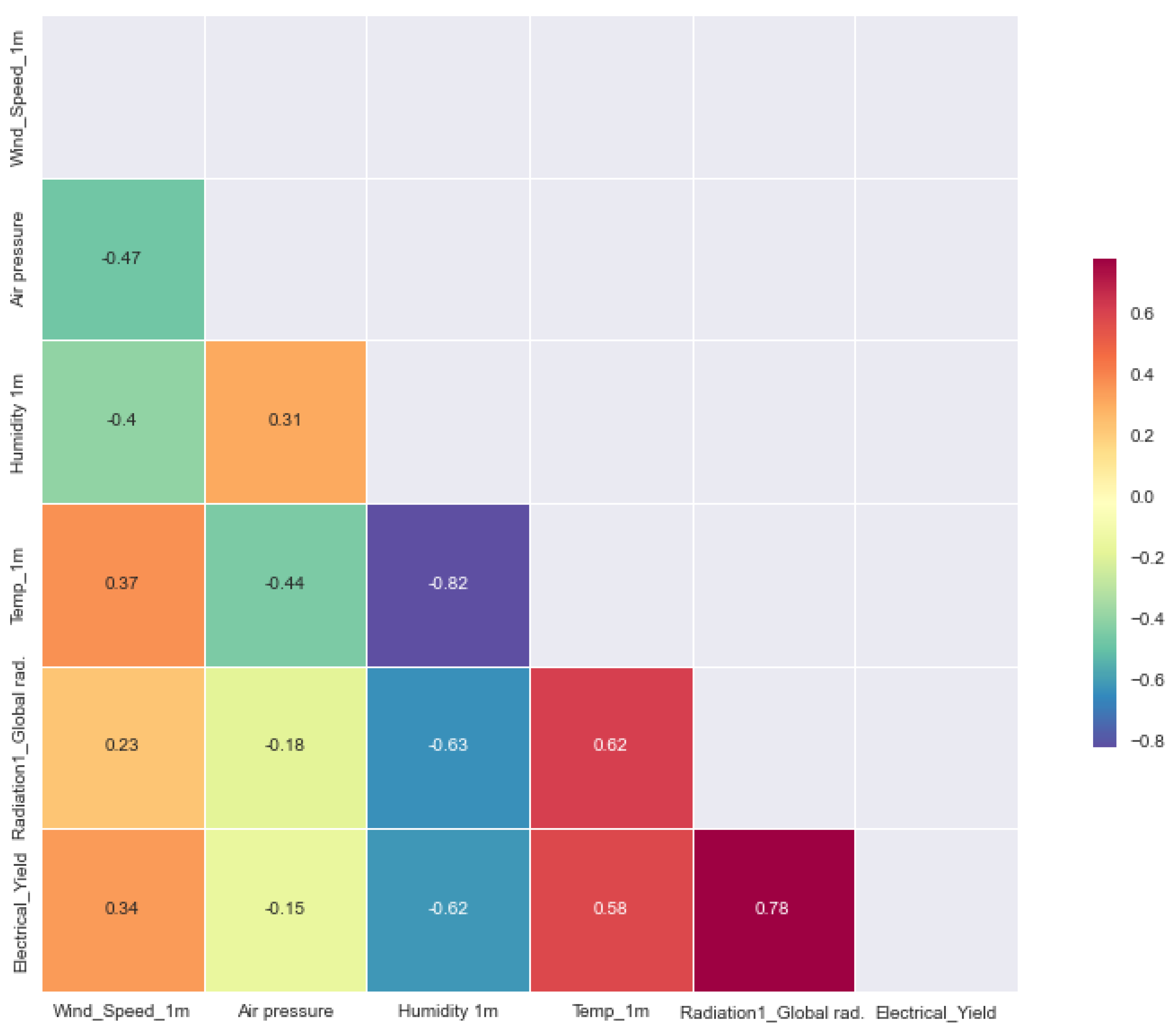
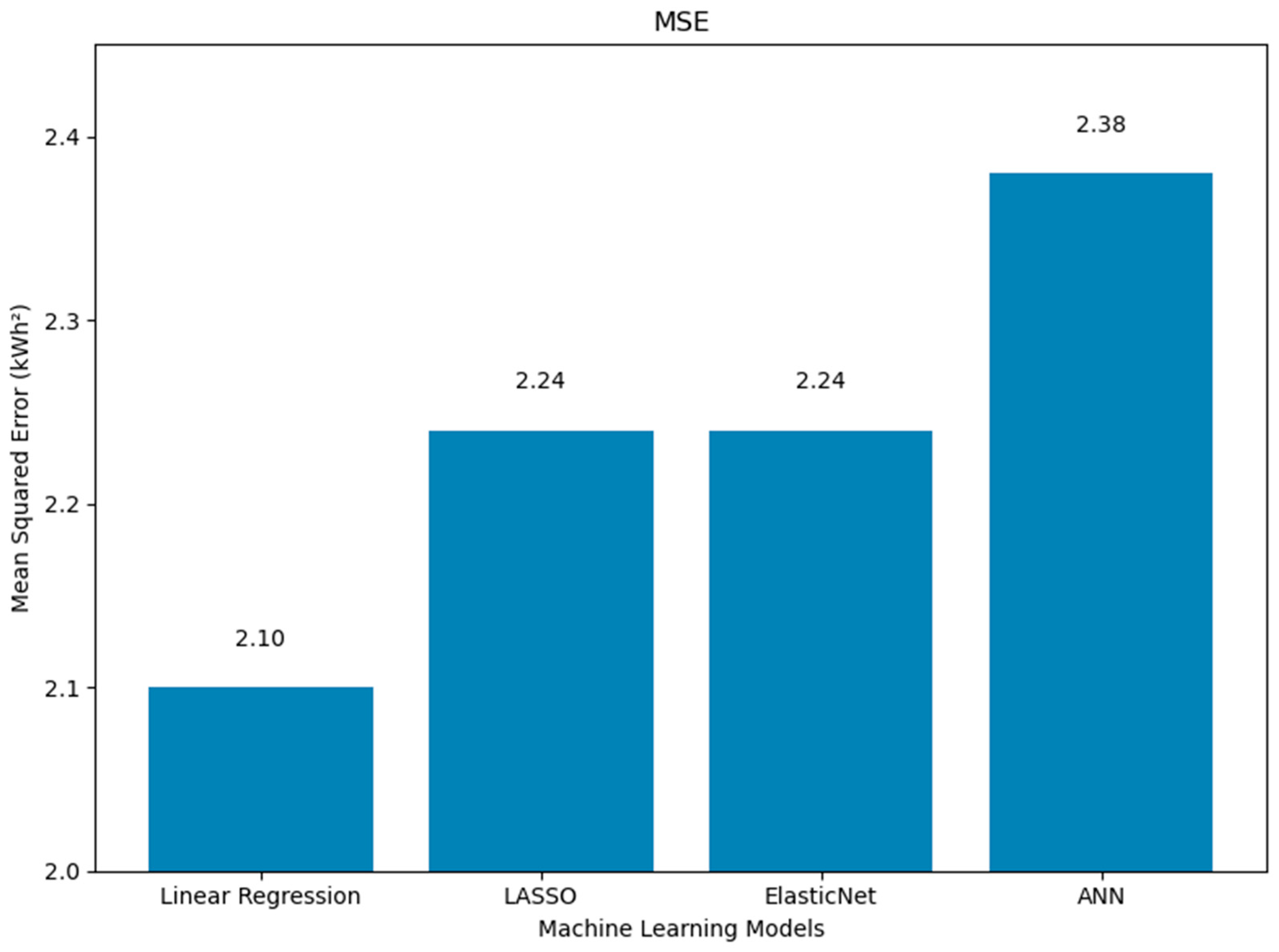
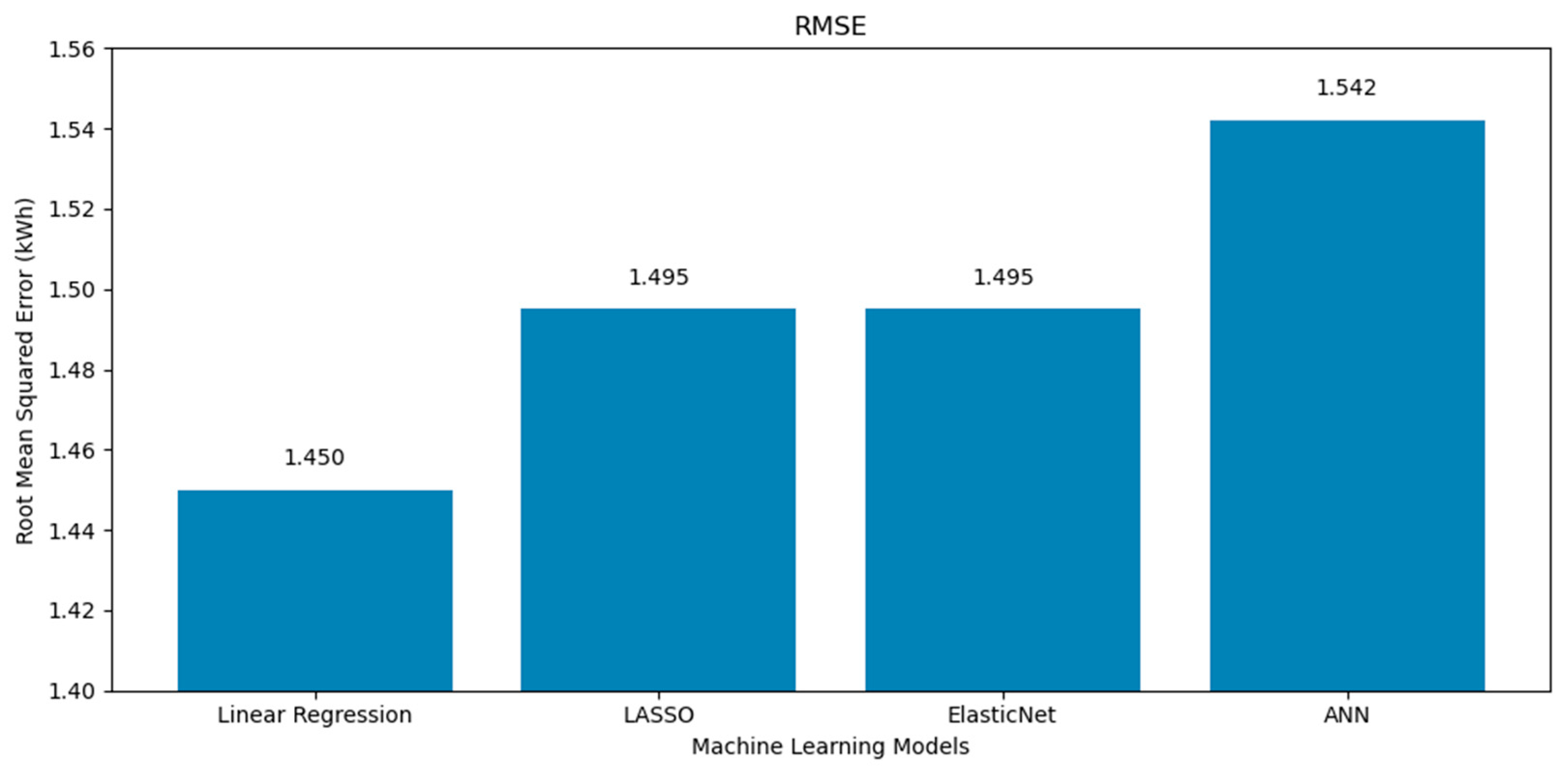
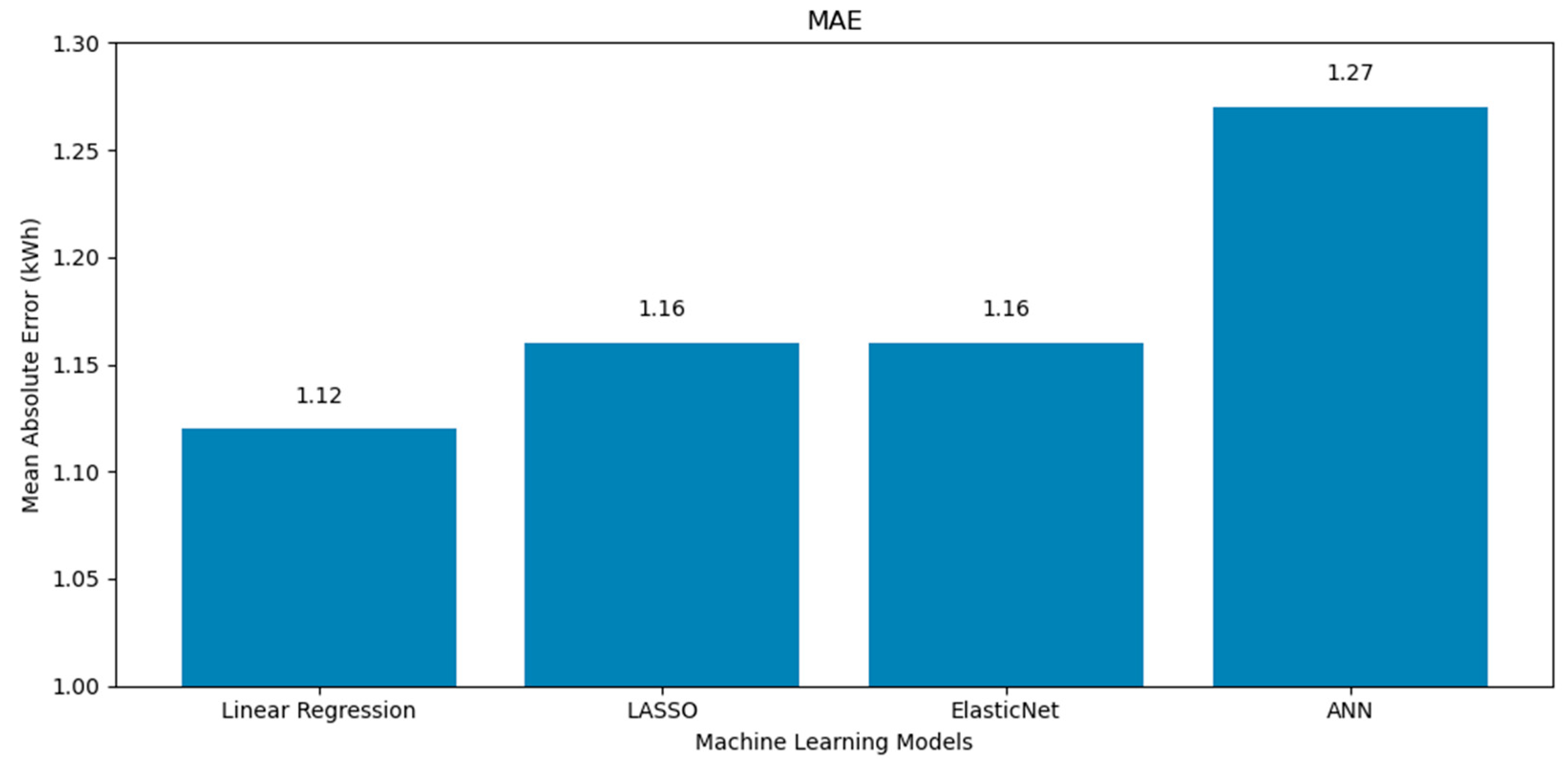
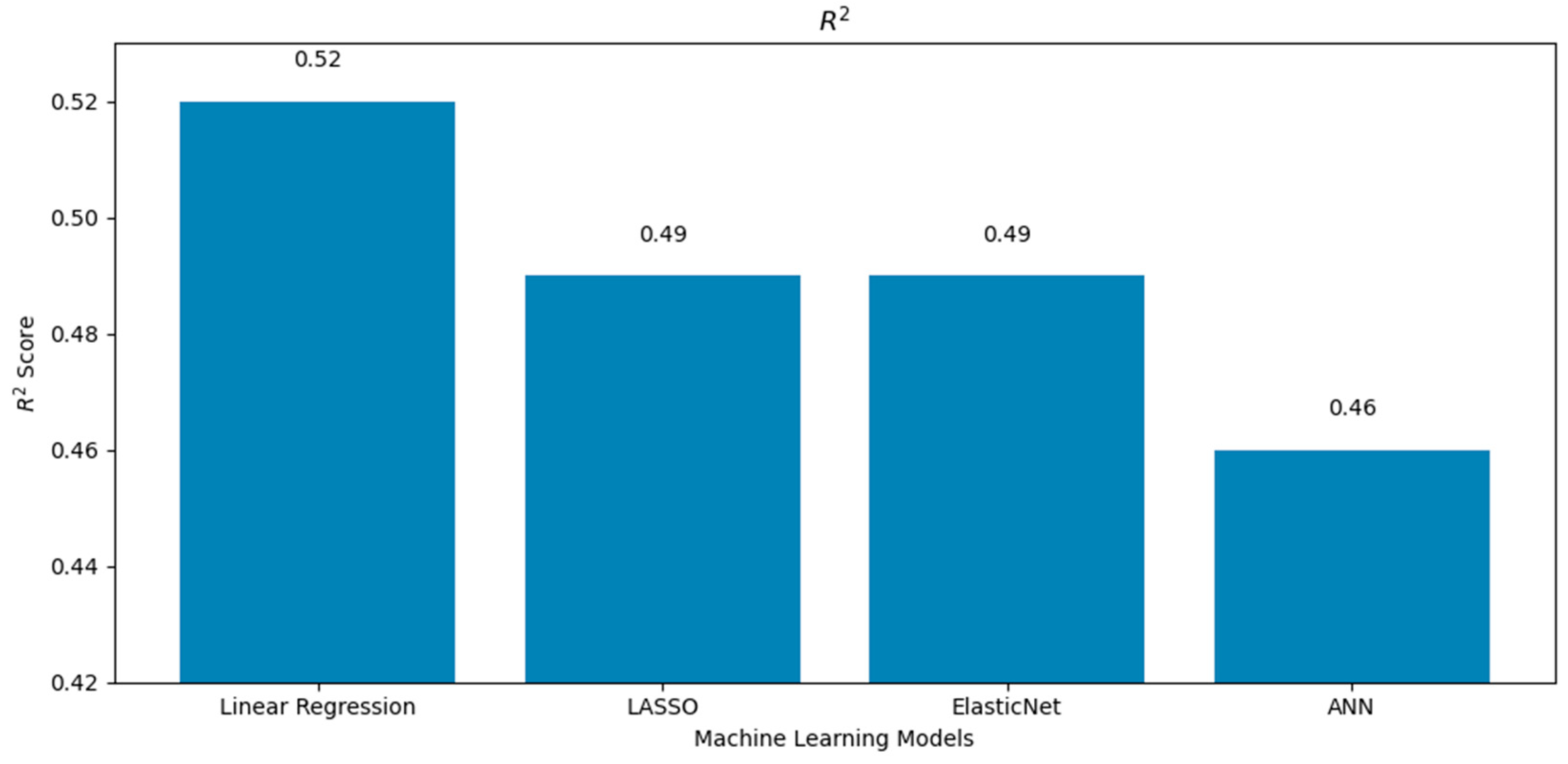
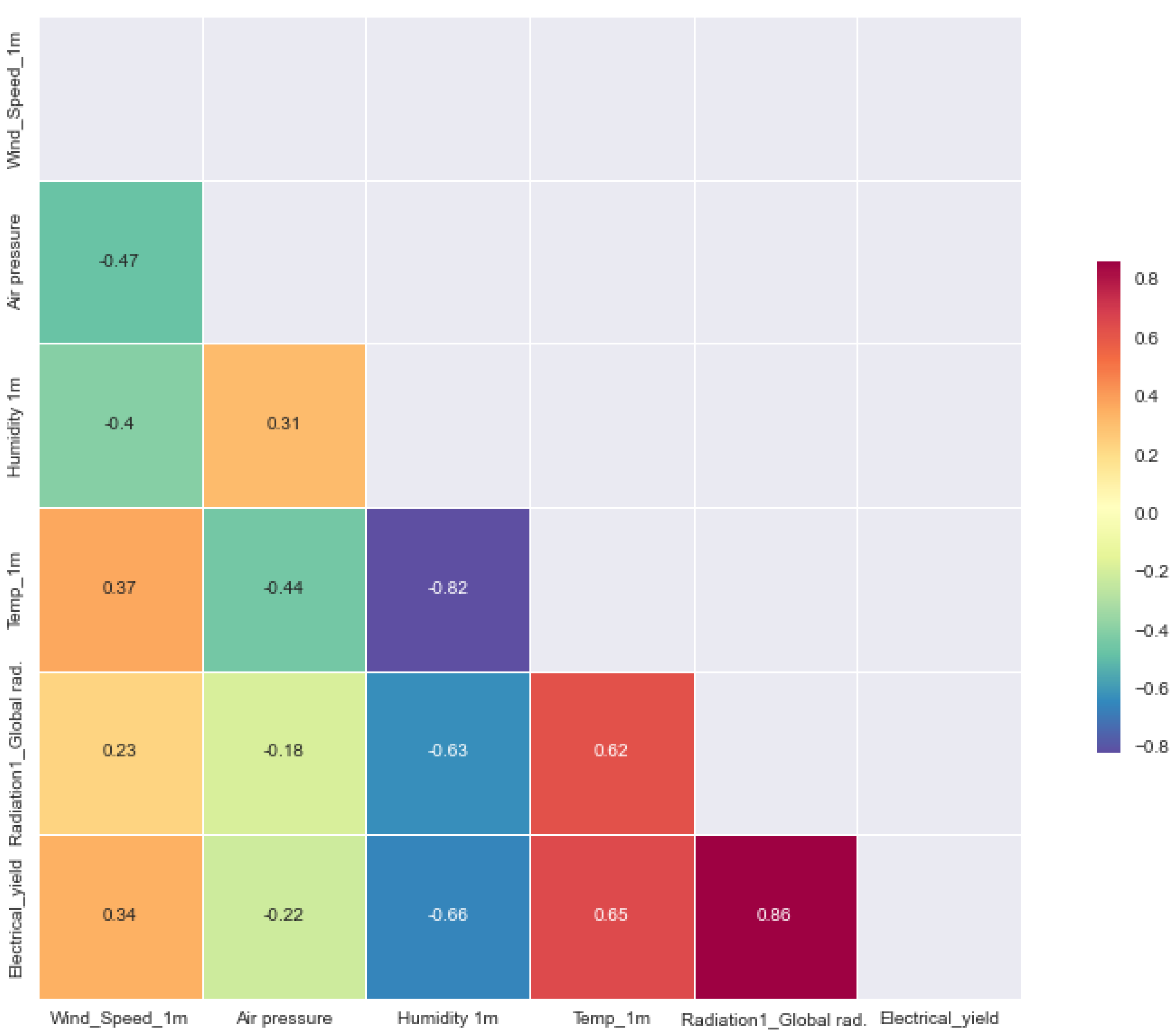
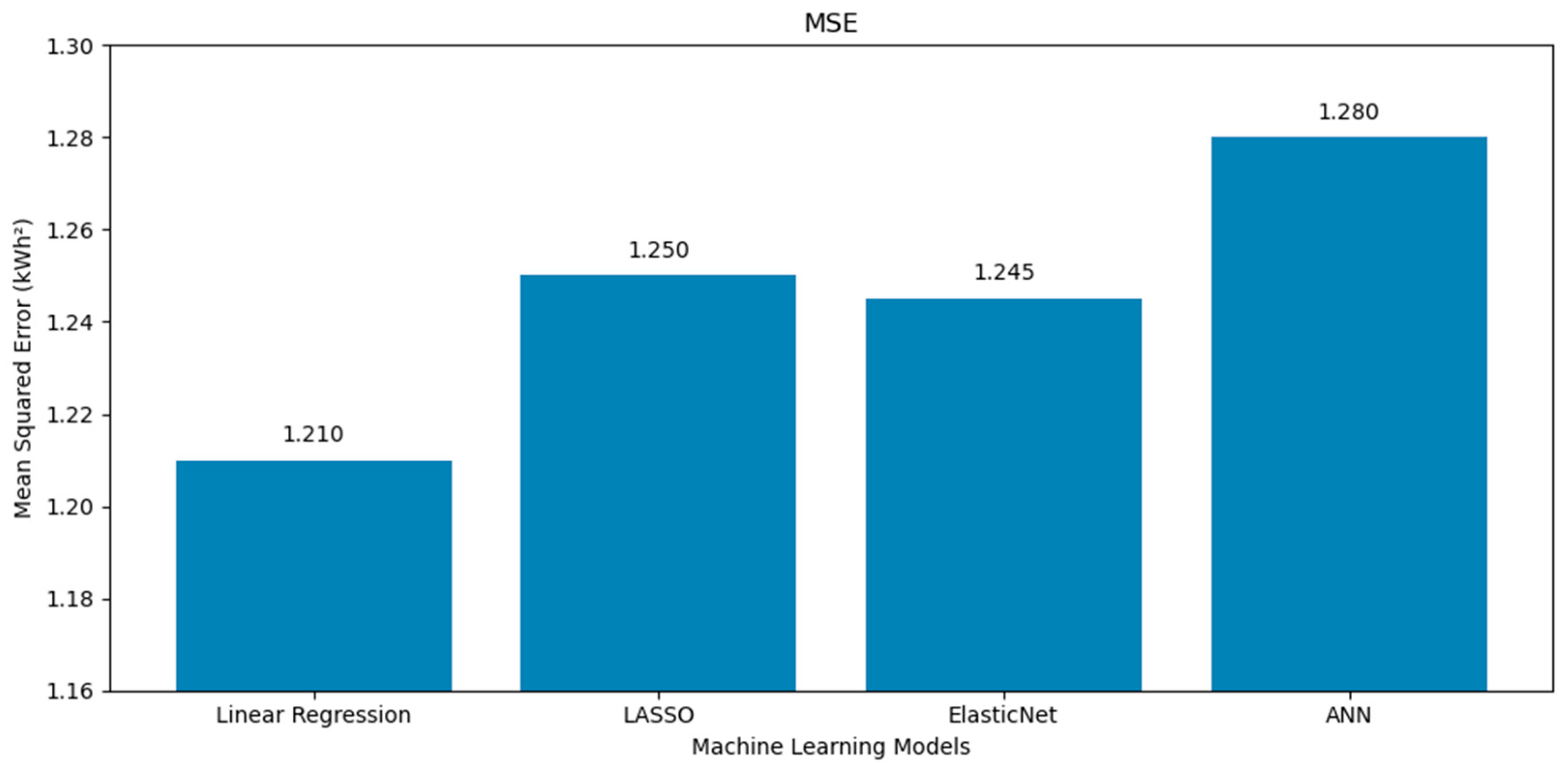
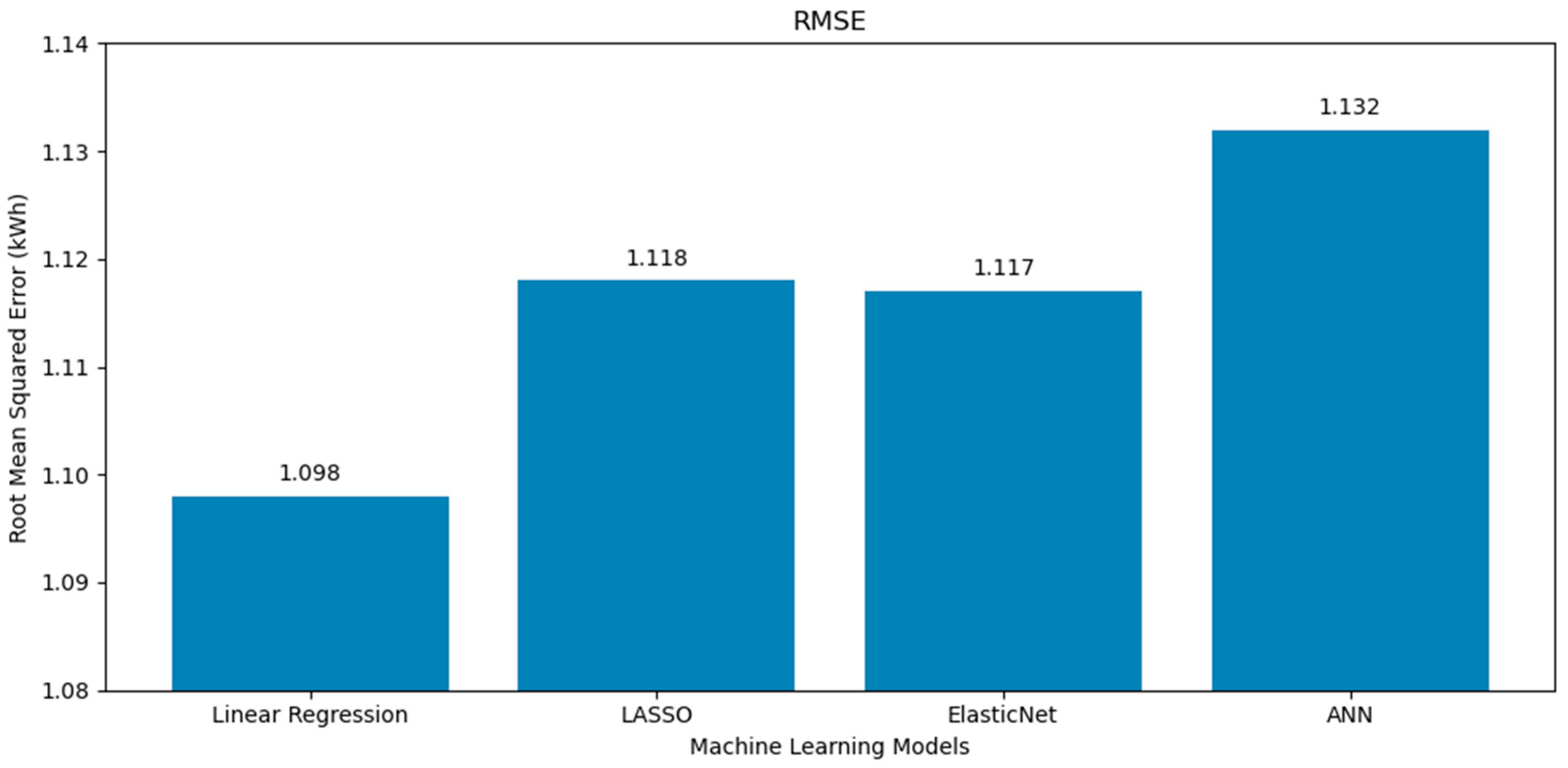
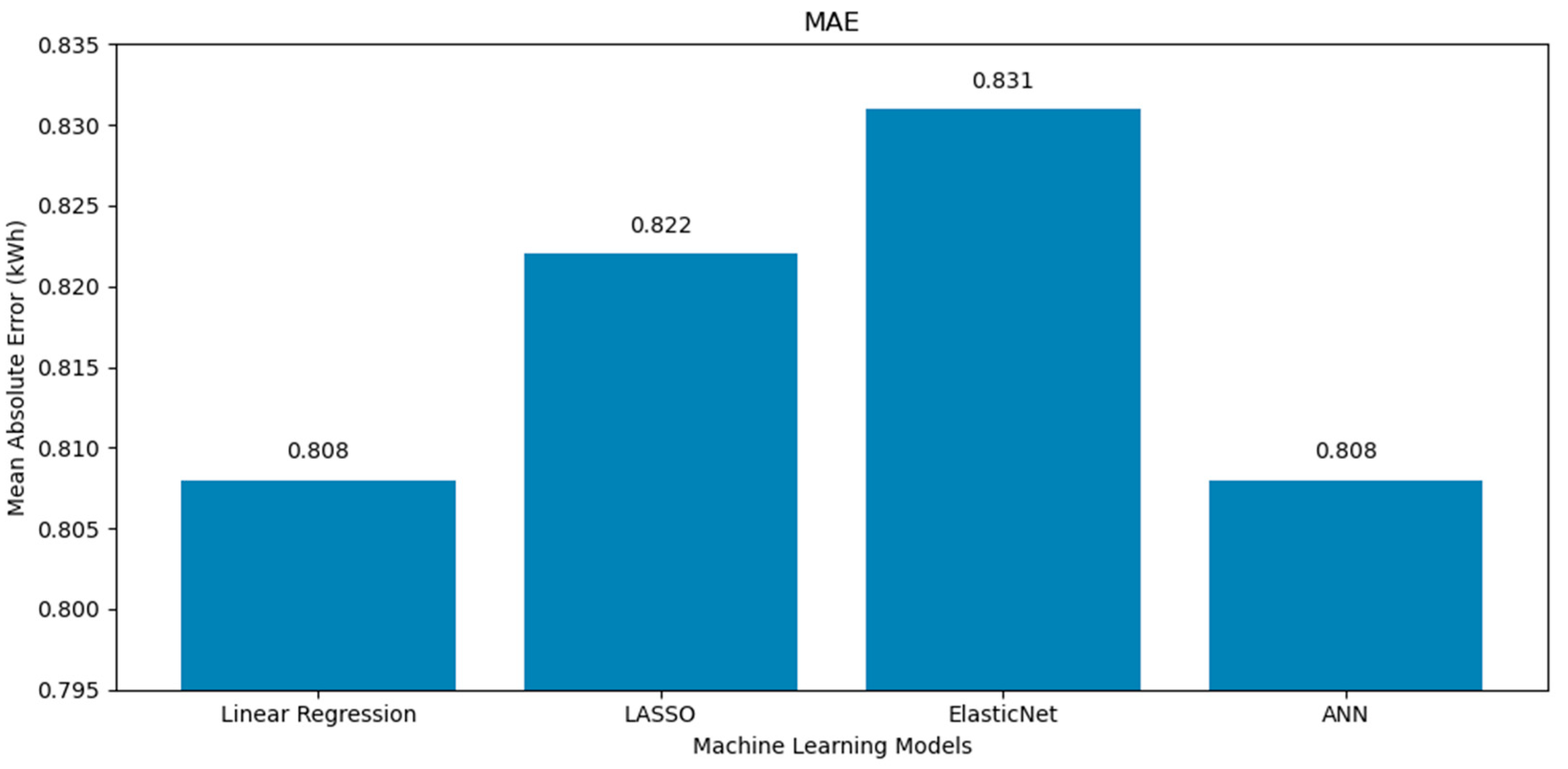
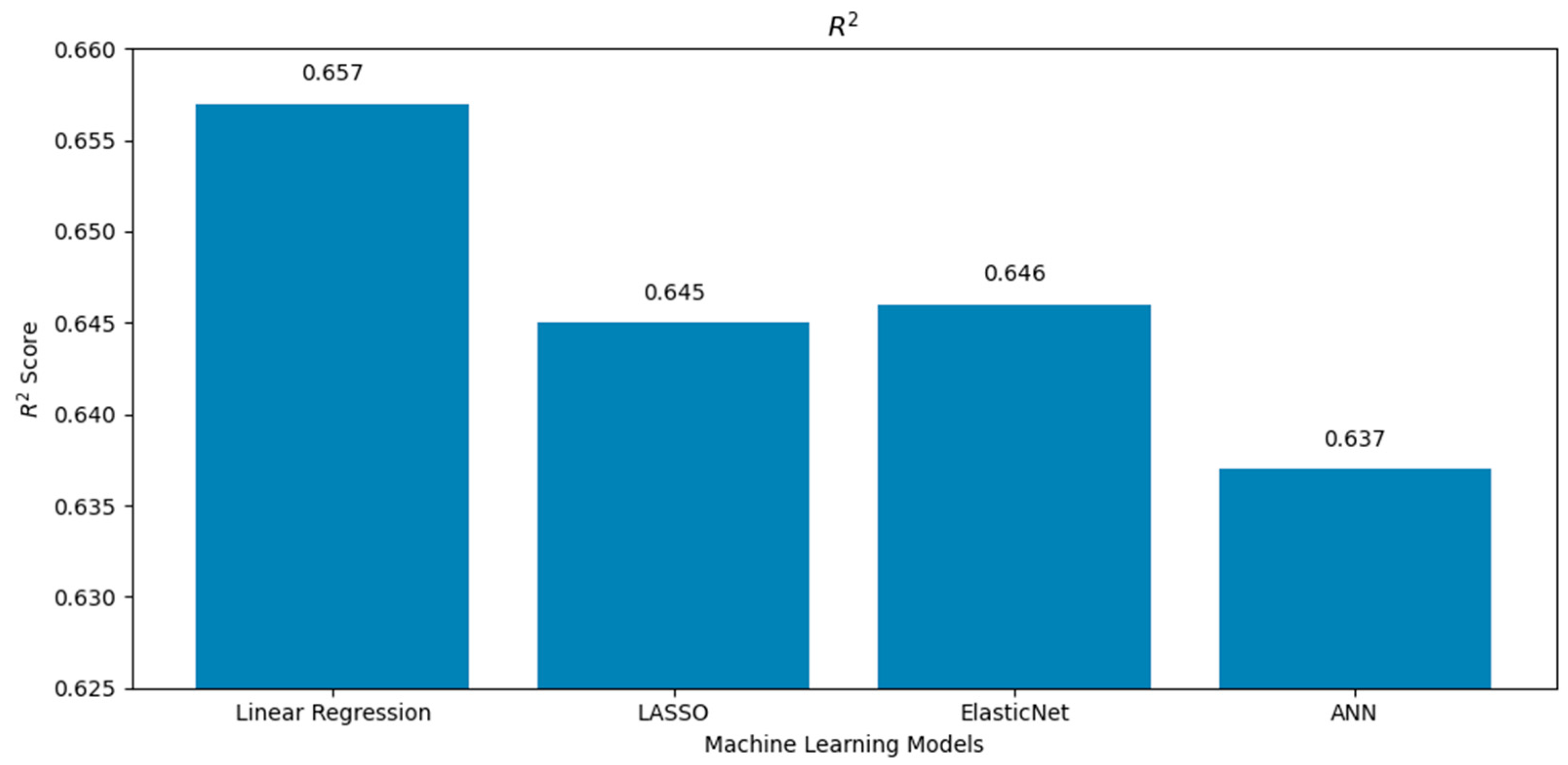
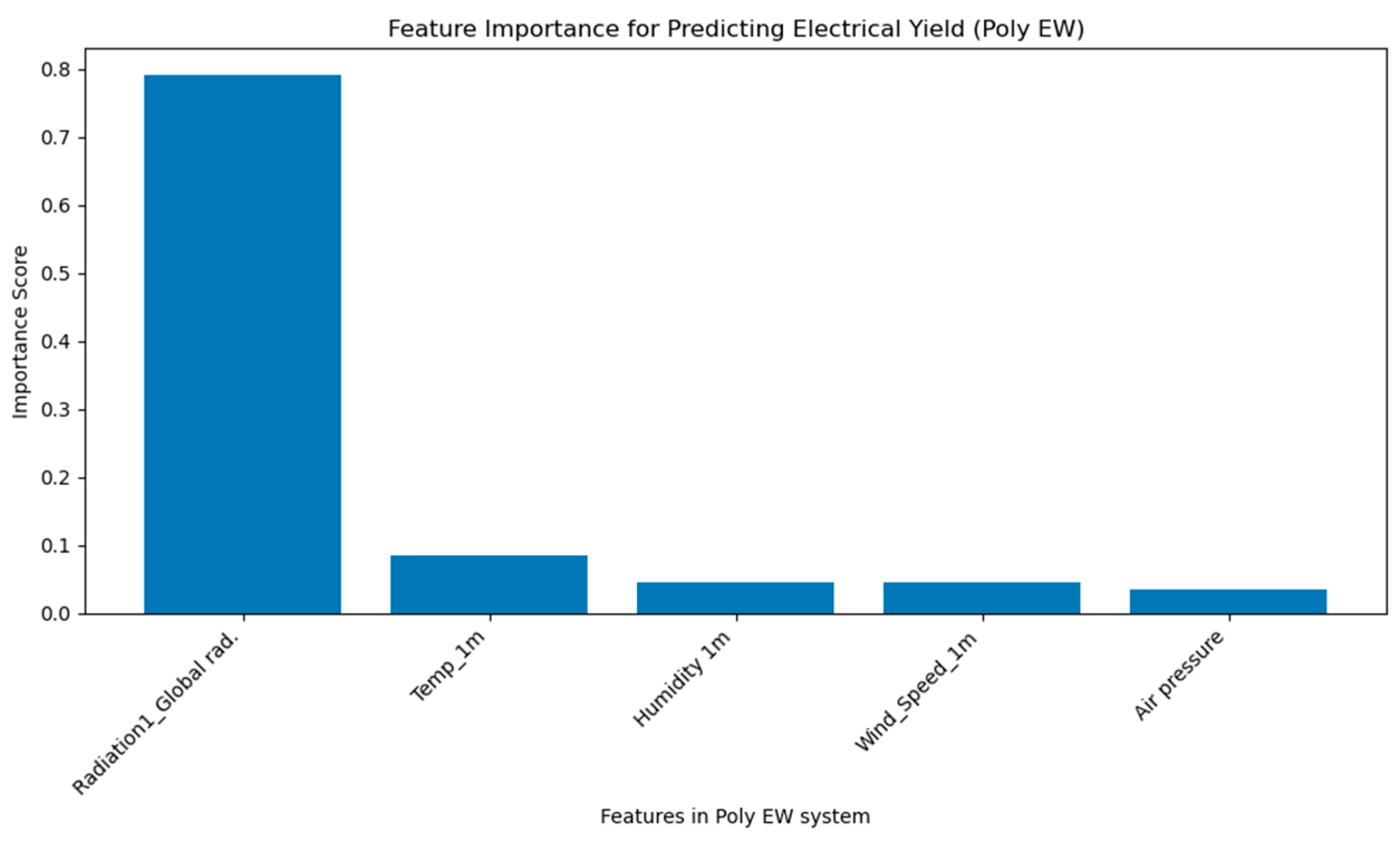
| Time | Wind Speed m/s | Air Pressure hPa | Humidity % | Temperature °C | Radiation W/m² | Electric Yield kWh |
|---|---|---|---|---|---|---|
| 8:00 | 0.68 | 915.4 | 92.8 | 6.6 | 73 | 0.42 |
| 9:00 | 0.56 | 915.9 | 89.7 | 7.8 | 116 | 0.96 |
| 10:00 | 0.64 | 916.3 | 81.6 | 9.3 | 314 | 2.28 |
| 11:00 | 0.96 | 916 | 74.8 | 10.1 | 531 | 3.74 |
| 12:00 | 0.76 | 915.3 | 71.5 | 10.4 | 351 | 3.08 |
| 13:00 | 1.04 | 914.5 | 71.1 | 11 | 393 | 3.32 |
| 14:00 | 0.8 | 913.7 | 67.1 | 11.7 | 465 | 4.04 |
| 15:00 | 0.84 | 913 | 59.9 | 12.3 | 355 | 2.66 |
| 16:00 | 0.96 | 912.6 | 56.3 | 12.9 | 231 | 1.06 |
| 17:00 | 0.84 | 912.2 | 61 | 11.3 | 42 | 0.26 |
| Time | Wind Speed m/s | Air Pressure hPa | Humidity % | Temperature °C | Radiation W/m² | Electric Yield kWh |
|---|---|---|---|---|---|---|
| 8:00 | 0.68 | 915.4 | 92.8 | 6.6 | 73 | 0.42 |
| 9:00 | 0.56 | 915.9 | 89.7 | 7.8 | 116 | 1 |
| 10:00 | 0.64 | 916.3 | 81.6 | 9.3 | 314 | 2.58 |
| 11:00 | 0.96 | 916 | 74.8 | 10.1 | 531 | 4.54 |
| 12:00 | 0.76 | 915.3 | 71.5 | 10.4 | 351 | 3.76 |
| 13:00 | 1.04 | 914.5 | 71.1 | 11 | 393 | 3.88 |
| 14:00 | 0.8 | 913.7 | 67.1 | 11.7 | 465 | 5.28 |
| 15:00 | 0.84 | 913 | 59.9 | 12.3 | 355 | 3.82 |
| 16:00 | 0.96 | 912.6 | 56.3 | 12.9 | 231 | 3.44 |
| 17:00 | 0.84 | 912.2 | 61 | 11.3 | 42 | 0.86 |
| Analytical Generation | Experimental Generation | |||||||
|---|---|---|---|---|---|---|---|---|
| Month | Poly East–West | Poly East–West | Poly South | Poly South | Poly East–West | Poly East–West | Poly South | Poly South |
| (kWh) | (kWh/kWp) | (kWh) | (kWh/kWp) | (kWh) | (kWh/kWp) | (kWh) | (kWh/kWp) | |
| Jan | 528.3 | 101.6 | 710.8 | 136.7 | 299.5 | 57.6 | 388.5 | 74.7 |
| Feb | 598.8 | 115.2 | 764.8 | 147.1 | 474.8 | 91.3 | 551.6 | 106.1 |
| Mar | 664.3 | 127.8 | 814.8 | 156.7 | 728.4 | 140.1 | 819.4 | 157.6 |
| Apr | 682.2 | 131.2 | 810.7 | 155.9 | 743.4 | 142.9 | 801.6 | 154.1 |
| May | 663 | 127.5 | 775.8 | 149.2 | 880.9 | 169.4 | 900.9 | 173.2 |
| Jun | 645.1 | 124.1 | 750.4 | 144.3 | 802.9 | 154.4 | 822.8 | 158.2 |
| Jul | 651.8 | 125.3 | 760.2 | 146.2 | 893.7 | 171.9 | 912.7 | 175.5 |
| Aug | 697.3 | 134.1 | 815.4 | 156.8 | 859.5 | 165.3 | 910.8 | 175.1 |
| Sep | 664.8 | 127.9 | 808.6 | 155.5 | 730.7 | 140.5 | 811.6 | 156.1 |
| Oct | 635.4 | 122.2 | 797.7 | 153.4 | 555.7 | 106.9 | 674.9 | 129.8 |
| Nov | 529.9 | 101.9 | 718.6 | 138.2 | 333.3 | 64.1 | 390.2 | 75.0 |
| Dec | 495.6 | 95.3 | 619.6 | 133 | 386.3 | 74.3 | 506.7 | 97.4 |
| Sum | 7456.5 | 1433.9 | 9147.4 | 1772.9 | 7689.4 | 1478.7 | 8491.7 | 1633.0 |
| PV System Type | Analytical Generation | Analytical Generation | Experimental Generation | Experimental Generation | Error |
|---|---|---|---|---|---|
| (kWh) | (kWh/kWp) | (kWh) | (kWh/kWp) | ||
| Poly east–west | 7456.5 | 1433.9 | 7689.4 | 1478.7 | 3.12% |
| Poly south | 9147.4 | 1772.9 | 8491.7 | 1633 | 7.89% |
| Analytical Generation | Experimental Generation | Prediction by Linear Regression Generation | ||||||||||
|---|---|---|---|---|---|---|---|---|---|---|---|---|
| Month | Poly East–West | Poly East–West | Poly South | Poly South | Poly East–West | Poly East–West | Poly South | Poly South | Poly East–West | Poly East–West | Poly South | Poly South |
| (kWh) | (kWh/kWp) | (kWh) | (kWh/kWp) | (kWh) | (kWh/kWp) | (kWh) | (kWh/kWp) | (kWh) | (kWh/kWp) | (kWh) | (kWh/kWp) | |
| Jan | 528.3 | 101.6 | 710.8 | 136.7 | 299.5 | 57.6 | 388.5 | 74.7 | 268.8 | 51.7 | 332.3 | 63.9 |
| Feb | 598.8 | 115.2 | 764.8 | 147.1 | 474.8 | 91.3 | 551.6 | 106.1 | 350.2 | 67.4 | 365.9 | 70.4 |
| Mar | 664.3 | 127.8 | 814.8 | 156.7 | 728.4 | 140.1 | 819.4 | 157.6 | 668.2 | 128.5 | 763.6 | 146.9 |
| Apr | 682.2 | 131.2 | 810.7 | 155.9 | 743.4 | 142.9 | 801.6 | 154.1 | 868.6 | 167.0 | 973. | 187.1 |
| May | 663 | 127.5 | 775.8 | 149.2 | 880.9 | 169.4 | 900.9 | 173.2 | 826.7 | 158.9 | 894.1 | 171.9 |
| Jun | 645.1 | 124.1 | 750.4 | 144.3 | 802.9 | 154.4 | 822.8 | 158.2 | 975.5 | 187.6 | 1059.3 | 203.7 |
| Jul | 651.8 | 125.3 | 760.2 | 146.2 | 893.7 | 171.9 | 912.7 | 175.5 | 844.9 | 162.5 | 845.2 | 162.5 |
| Aug | 697.3 | 134.1 | 815.4 | 156.8 | 859.5 | 165.3 | 910.8 | 175.1 | 889.9 | 171.2 | 938.5 | 180.5 |
| Sep | 664.8 | 127.9 | 808.6 | 155.5 | 730.7 | 140.5 | 811.6 | 156.1 | 777.3 | 149.5 | 872.9 | 167.9 |
| Oct | 635.4 | 122.2 | 797.7 | 153.4 | 555.7 | 106.9 | 674.9 | 129.8 | 626.3 | 120.5 | 710.8 | 136.7 |
| Nov | 529.9 | 101.9 | 718.6 | 138.2 | 333.3 | 64.1 | 390.2 | 75.0 | 359.7 | 69.2 | 397.4 | 76.4 |
| Dec | 495.6 | 95.3 | 619.6 | 133 | 386.3 | 74.3 | 506.7 | 97.4 | 397.9 | 76.5 | 469.1 | 90.2 |
| sum | 7456.5 | 1433.9 | 9147.4 | 1772.9 | 7689.4 | 1478.7 | 8491.7 | 1633.0 | 7854.3 | 1510.5 | 8622.3 | 1658.2 |
| PV System Type | Experimental Generation | Generation Predicted by Linear Regression | Error |
|---|---|---|---|
| (kWh/kWp) | (kWh/kWp) | ||
| Poly east–west | 1478.7 | 1510.45 | 2.1% |
| Poly south | 1633 | 1658.15 | 1.5% |
Disclaimer/Publisher’s Note: The statements, opinions and data contained in all publications are solely those of the individual author(s) and contributor(s) and not of MDPI and/or the editor(s). MDPI and/or the editor(s) disclaim responsibility for any injury to people or property resulting from any ideas, methods, instructions or products referred to in the content. |
© 2025 by the authors. Licensee MDPI, Basel, Switzerland. This article is an open access article distributed under the terms and conditions of the Creative Commons Attribution (CC BY) license (https://creativecommons.org/licenses/by/4.0/).
Share and Cite
Faouri, S.S.; Abdallah, S.; Salameh, D.H. Using Machine Learning and Analytical Modeling to Predict Poly-Crystalline PV Performance in Jordan. Energies 2025, 18, 3458. https://doi.org/10.3390/en18133458
Faouri SS, Abdallah S, Salameh DH. Using Machine Learning and Analytical Modeling to Predict Poly-Crystalline PV Performance in Jordan. Energies. 2025; 18(13):3458. https://doi.org/10.3390/en18133458
Chicago/Turabian StyleFaouri, Sinan S., Salah Abdallah, and Dana Helmi Salameh. 2025. "Using Machine Learning and Analytical Modeling to Predict Poly-Crystalline PV Performance in Jordan" Energies 18, no. 13: 3458. https://doi.org/10.3390/en18133458
APA StyleFaouri, S. S., Abdallah, S., & Salameh, D. H. (2025). Using Machine Learning and Analytical Modeling to Predict Poly-Crystalline PV Performance in Jordan. Energies, 18(13), 3458. https://doi.org/10.3390/en18133458












